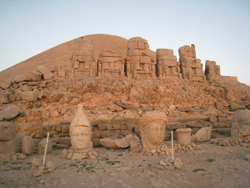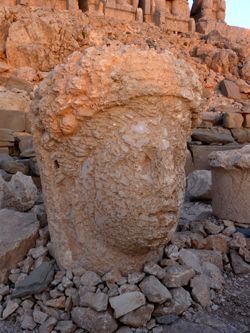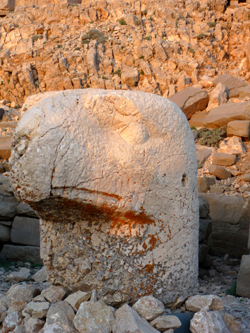Commagene was a small kingdom of the Hellenistic Age, located in south-central of modern Turkey, with its capital at Samosata (modern Samsat, near the Euphrates). It was first mentioned in Assyrian texts as Kummuhu, which was normally an ally of Assyria, but eventually annexed as province in 708 BC under Sargon II. The Persian Empire then conquered Commagene in the 6th century BC, and Alexander the Great conquered the territory in the 4th century BC. After the breakup of the Alexandrian Empire, Commagene was a state and province in the Greco-Syrian Seleucid Empire.
 |
 |
 |
 |
Commagene being one of the Seleucid successor states occupied a land in between the Taurus mountains and the Euphrates. The state of Commagene had a wide range of cultures which left its leader from 62 BCE – 38 BCE
In 62 BC, Antiochos I became king of Commagene and developed his kingdom as a strategic crossroad on the important trade routes between Syria, Mesopotamia and Rome.
Mount Nemrut & Antiochus
Antiochus is famous for building the impressive religious sanctuary of Mount Nemrut . The mountain lies 40 km (25 mi) north of Kahta, near Adıyaman. In 62 BC, King Antiochus I Theos of Commagene built on the mountain top a tomb-sanctuary flanked by huge statues (8–9 m/26–30 ft high) of himself, two lions, two eagles and various Greek, and Armenian gods, such as Hercules-Vahagn, Zeus-Aramazd or Oromasdes (associated with the Iranic god Ahura Mazda), Tyche, and Apollo-Mithras.
Beliefs
Antiochus left Greek inscriptions revealing many aspects of his religion and explaining his purpose of action. In one inscription, Antiochus suggests his tomb must be in a high and holy place, remote from the people and close to the gods with whom he is in rank. Antiochus wanted his body to be preserved for eternity. The gods he worshiped were a syncretism of Greek and Persian deities, some of them personifications of the Sun, Moon and planets. The monumental effigies had Persian and Greek influences. Persian influences were the clothes, headgear and the colossal state of the deities. While the Greek influences were representation of the gods and showing ancestors of the king.
Antiochus practiced astrology of a very esoteric kind, and laid the basis for a calendrical reform, by linking the Commagene year, which till then had been based on the movements of the Moon, to the Sothic (Star of Sirius) cycle used by the Egyptians as the basis of their calendar.
Antiochus’ version of Hermeticism where his remains were buried. His tomb was constructed in a way that religious festivities could happen. Each month Antiochus had two festivities: his birthday which was celebrated on the 10th of each month and his coronation which was celebrated on the 16th of each month. He would allocate funds for these events.
The priests would place incense, herbs and sacrifices on the altars. All the citizens and military garrison were invited to the banquets in honor of the illustrious deceased. During feasts, grudging attitudes were forbidden and priests decreed that the people should enjoy themselves, eat and drink wine. Wine was served however, it was allowed to be consumed during the one day festivities. Antiochus created women musicians for the banquets. Antiochus’ tomb was forgotten for centuries, until 1883 when archaeologists from Germany excavated the tomb. According to inscriptions, Antiochus appeared to have been a pious person and had a generous spirit.
In another city of the kingdom Arsameia, ruins were found of the royal palace. This palace is known as Eski Vale or Old Castle. In Arsameia, Antiochus left many inscriptions in Greek of his public works program and how he glorified the city..
 WORLD HERITAGE:
WORLD HERITAGE:
**Adiyaman/NEMRUT MOUNTAIN
Date of Inscription to the World Heritage List: 6.12.1987
List Reference: 448 Criteria: Cultural
KEY SITES: Mount Nemrut-Arsemia- Kahta (Adiyaman)
